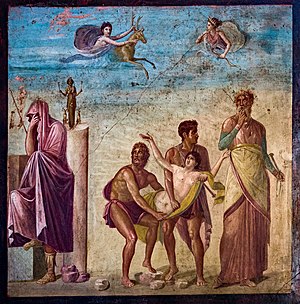
Back إيفيجينيا Arabic İfigeniya AZ Іфігенія BE Ифигения Bulgarian Ifigeneia BR Ifigenia Catalan Ífigenie Czech Ifigenia Danish Iphigenie German Ιφιγένεια Greek


In Greek mythology, Iphigenia (/ɪfɪˈdʒɪ.nɪə/; Ancient Greek: Ἰφιγένεια, romanized: Iphigéneia, pronounced [iːpʰiɡéneː.a]) was a daughter of King Agamemnon and Queen Clytemnestra, and thus a princess of Mycenae.
In the story, Agamemnon offends the goddess Artemis on his way to the Trojan War by hunting and killing one of Artemis' sacred stags. She retaliates by preventing the Greek troops from reaching Troy unless Agamemnon kills his eldest daughter, Iphigenia, at Aulis as a human sacrifice. In some versions, Iphigenia dies at Aulis, and in others, Artemis rescues her.[1] In the version where she is saved, she goes to the Taurians and meets her brother Orestes.[2]
- ^ Nelson, Thomas J. (2022). "Iphigenia in the Iliad and the Architecture of Homeric Allusion". TAPA. 152: 55–101. doi:10.1353/apa.2022.0007. S2CID 248236106.
- ^ Evans (1970), p. 141